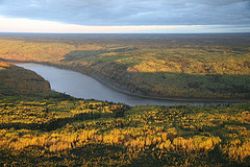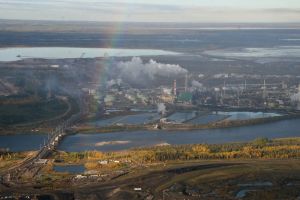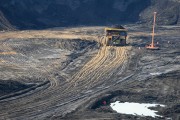Today, the Royal Society report on oilsands found serious problems with monitoring oilsands development. Now we are anxiously awaiting the report of a federal panel, also set up to review Alberta's monitoring of pollutants downstream from the oilsands. The report is also due this week.
The panel was struck back in September, soon after former Environment Minister Jim Prentice said he was "disgusted" by images of disfigured and diseased fish from the Athabasca River. Peer-reviewed studies by David Schindler, an internationally renowned water expert, and his team found elevated levels of toxins downstream from oilsands operations.
 "The purpose of the inquiry and the work of these scientists is to tell us what a state-of-the-art, world-class monitoring system should look like. To get the best scientific advice on that," Prentice told the CBC at the time.
"The purpose of the inquiry and the work of these scientists is to tell us what a state-of-the-art, world-class monitoring system should look like. To get the best scientific advice on that," Prentice told the CBC at the time.
We are keenly awaiting the report's conclusions.
Setting up the panel was a good move, especially in light of the recent and damning report from the Environment Commissioner who noted that the federal government itself has not taken basic steps such as, "defining its responsibilities and responding to the threats to Canada's water resources that it has identified."
The commissioner also pointed out that Environment Canada has only one long-term water quality monitoring station in the Athabasca River, and this station was not designed to monitor pollutants related to oilsands development. 
Clearly, the pressure on the federal government to up its game on environmental management in the oilsands is intensifying.
Here are nine points to look for in the federal panel's report:
- Science-based limits: Limits are needed to protect the aquatic ecosystem and should not be exceeded for the sake of industrial development. Science-based limits are critical to effective monitoring systems.
- Monitoring as a tool for decision-making: Continuous, consistent, independent and holistic water monitoring that uses both scientific and traditional knowledge is essential to detect environmental changes and longer-term trends in the Athabasca River Basin and in turn inform regulatory decision making. Responsible regulatory decision-making cannot occur in the absence of effective monitoring programs and limits on pollution.
- Governance: The governance of a monitoring program for the Athabasca River Basin should consist of a group of independent, academic scientists that are unaffiliated with industry.
- Resourcing: Funding for monitoring in the Athabasca River Basin should be a shared responsibility between industry and government. Currently there is concern about the low level of financial support for monitoring in the Athabasca River Basin provided by the provincial and federal governments.
- Transparency: All monitoring data should be transparent and publicly available for further analysis.
- Rigour: The collection and analysis of monitoring data should use state-of-the-art technology and be analytically rigorous.
- Consider mining and in situ oilsands development: Monitoring should consider both the impacts of mining and in situ development. Both development types result in a suite of unique impacts on fresh and/or ground water. Monitoring should comprehensively capture the impacts of both development types.
- Pollution impacts: The panel's review of existing information should identify all pollutants and their corresponding impact on aquatic resources.
- Next steps and recommendations: Given public concern regarding pollution in the Athabasca River Basin, the panel should provide recommendations for the make up of a subsequent scientific advisory panel that would be responsible for future oversight of monitoring in the Athabasca River Basin. Recommendations and next steps should address identified information gaps, roles, responsibilities, funding, enforcement and reporting.
The Alberta and Federal Governments have already approved a doubling of oilsands developments. All new approvals should be halted until independent monitoring systems and environmental limits are put in place.









